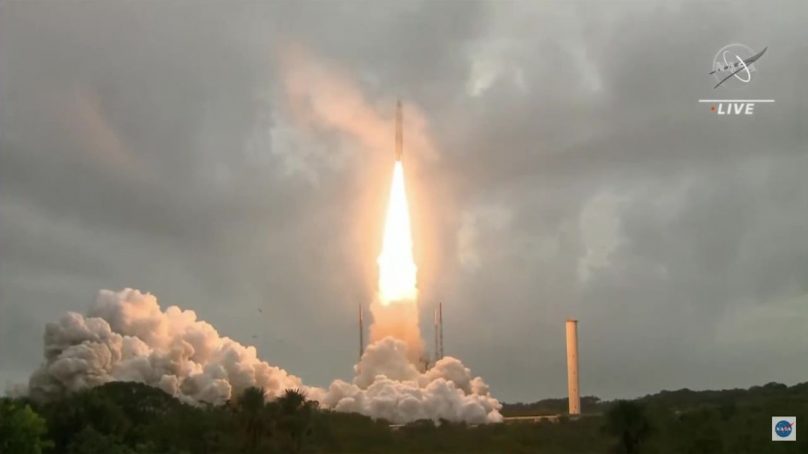
It was a big-science project plagued with so many problems that it seemed destined to fail. For years, the James Webb Space Telescope – an ambitious observatory planned and funded by NASA, the European Space Agency and the Canadian Space Agency – was the target of astronomy’s most scathing jokes.
Delayed for more than a decade owing to technical and management problems, Webb’s development and operations budget ultimately ran to almost $10 billion, far above the initial $1 billion estimated when the project was conceived.
Yet on December 25, 2021, an Ariane 5 rocket lifted into the skies above French Guiana and carried Webb into space. Within half an hour of launch, the telescope separated from the rocket. It subsequently embarked on an intricate dance of deployments to unfold major pieces, including a tennis-court-sized sunshield and a 6.5-metre-wide primary mirror.
On January 24, Webb reached its ultimate destination, an orbit around the L2, or the second Lagrange point, some 1.5 million kilometres from Earth. Holding its sunshield behind itself like a giant umbrella to keep its mirrors and four scientific instruments in the shade, the telescope will now prepare to begin observing the Universe.
Webb was designed as a next-generation infrared telescope to succeed the Hubble Space Telescope. Between now and June – the earliest that science results are expected – the telescope will cool down to its operating temperature and start up and calibrate its instruments.
Remarkably, Webb has pulled off an essentially flawless deployment so far. Scientists and engineers are breathing huge sighs of relief. It’s an apt moment to assess how other big-science projects can avoid the pitfalls that plagued Webb – and to look ahead to the astronomy that scientists hope the telescope will reveal. There are also management lessons to be learnt.
For many astronomers working on an upcoming space mission, the number-one aim is probably to avoid the problems that bedevilled Webb. These boil down to two interconnected faults: the massive underestimate of the project costs and the failure to stop scientists adding a host of new technologies along the way.
NASA gave Webb the greenlight in 2002, expecting it to launch within a decade. But throughout the 2000s, the agency and its main contractor, Northrop Grumman in Falls Church, Virginia, struggled to turn ambitious designs into functional hardware that could fly in space.
No one had ever built anything like the enormous sunshield — made of five gossamer-thin layers that had to be folded for launch and then unfolded in space — or the similarly folded primary mirror. All had to be designed, built, tested and retested from scratch. Scientists kept asking for more capabilities, and engineers kept adding more complexity to satisfy them.
In 2010, an independent review, now a classic in the literature of project management, flagged fundamental errors, including the failure to produce multiple bottom-up estimates of the true cost of the telescope as time went on. (Even early on, few believed the initial $1-billion estimate.)
The main problem was that NASA management had accepted an unrealistically low figure and had not adjusted its thinking adequately as time went on. By 2011, Congress was fed up with cost overruns and lawmakers threatened to cancel it. Ultimately, Webb cost NASA $8.8 billion to develop — nearly double the amount expected even in 2009. It is the most expensive telescope in history.
NASA has worked hard to try to avoid the pitfalls that afflicted Webb from affecting future missions, such as the Nancy Grace Roman Space Telescope. This is the big space telescope the agency is building to follow Webb, and should be launched in 2027.
Managers on the Roman project have been relentless in their efforts to keep the mission to its cost cap, with the main extra expense so far the result of Covid-19-induced delays, which pushed costs up by almost $400 million to $4.3 billion.
Project managers in other areas of science would do well to follow this model, and regularly acquire independent cost estimates, as well as periodic reviews as the Roman project managers have done, to be sure they remain on track.
Clearly, no one should ever build a telescope in the way NASA built Webb. But now that the observatory is in space and so close to being functional, it is time to sing its praises. Humanity has never built such an awesome machine.
With its gigantic mirror and sensitive instruments, Webb will peer at the Universe in infrared wavelengths. It will almost certainly — and immediately — smash the record for the most-distant galaxy ever observed, and study such galaxies for clues to the evolution of the Universe. It will sniff out molecules such as carbon dioxide and water vapour in the atmospheres of exoplanets, helping scientists to understand the chances of life on these other worlds. It will reveal the secrets of star formation by peering through the dust that enshrouds stellar nurseries and prevents them from being seen with other wavelengths of light.
In line with our support for open data, Nature reaffirms that the journal will have no embargo on any early-release science (data from the first five months of observations); nor on the first year of science, known as Cycle 1 of the General Observers programme. We can hardly wait for the insights that the telescope will bring.
- A Nature report











